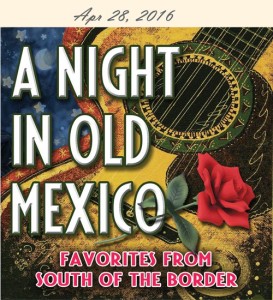[su_row]
[su_column size=”1/2″]

Concert April 28, 2016 at 7:30 PM
Wine & Cheese Reception 6:30 pm
Cailloux Theater – Kerrville, Texas
[/su_column]
[su_column size=”1/2″]
Evening’s Performances
Huapango José Pablo Moncayo García
Night In Mexico Creston
Estrellita Ponce
Concierto del Sur Ponce
Danzon No. 2 Marquez
Mexican Rhapsody McBride
[su_row]
[/su_column]
[su_column size=”1/2″]
To learn more about this concert, see the Conductor Letter and Program Notes below.
[/su_column]
[/su_row]
Conductor Letter
[su_row]
[su_column size=”1/2″]
Dear Friends of the Symphony of the Hills,
I love attending concerts where an occasional “bravo” or “hurray” is shouted enthusiastically after the performance. You just can’t contain your excitement when you are so excited about the music. In the Mexican folkloric music tradition, we don’t wait until the end to shout—we let it out when the spirit moves us! That is called a grito in Spanish. I love to hear a good grito, sometimes accompanied by some whistling, too! The music selected for our final concert of the 2015-16 Symphony of the Hills season promises to get you in the mood for some cheering!
On our final concert of this season you will hear classical orchestral favorites from Mexican and American composers, all inspired by the cultural and historical richness from our south of the border neighbor. Included on this concert are Creston’s “Night in Mexico,” Ponce’s Concierto del Sur for classical guitar and orchestra featuring Matthew Dunne, guitar soloist, and Marquez’s Danzon No. 2.
[/su_column]
[su_column size=”1/2″]
We will also feature what is for all practical purposes, the national song of Mexico, Huapango by Moncoya, and McBride’s Mexican Rhapsody among other works. You will be lifted up and celebrating this Fiesta-themed concert right in the heart of the Texas Hill Country!
If you enjoy this Symphony of the Hills concert, I hope you will join our concert sponsor and others throughout the season whose passionate support keeps symphonic orchestral music vibrant in our community.
Thank you for your attendance and support of classical orchestral music in the Hill Country. ¡Gracias por todo! We hope to see you next fall to kick off our 2016-17 season!
With sincere best wishes for a wonderful summer,
Gene Dowdy
Conductor & Artistic Director
[/su_column]
[/su_row]
Program Notes[su_row]
[su_column size=”1/2″]
Huapango
José Pablo Moncayo García
Born in Guadalajara, Jalisco, José Pablo Moncayo was introduced to music by his elder brother Francisco, and entered the study of music at the National Conservatory at age 17. In order to finance his studies, he worked as a jazz pianist, while taking courses such as harmony, counterpoint and analysis (also called musical forms). He was recognized in his early ‘20’s for his ability to do sight reading at the piano.
At the first performance of the Renovation Musical Society (Sociedad Musical “Renovación”) on August 22, 1931, Moncayo presented two of his own compositions, Impressions in a Forest, and Impression, both for solo piano. In 1932 he was invited to join the Symphony Orchestra of Mexico (OSM) as a percussionist, and shortly thereafter was introduced to Aaron Copland by Carlos Chavez, the conductor of the Symphony Orchestra.
Moncayo’s Huapango was premièred on 15 August 1941, at the Palace of Fine Arts by the Symphony Orchestra of Mexico conducted by Carlos Chávez. That summer, and probably thanks to the recommendations of Chávez and Copland, Moncayo was granted scholarships from the Rockefeller Foundation to study at the Berkshire Music Institute, known today as the Tanglewood Music Center. Moncayo worked in Berkshire not only on his first symphony composition but also completed another work, probably in Copland’s composition course, Llano Grande for chamber orchestra, which was premiered by the orchestra during the Berkshire Festival precisely on 21 August. During the same period, Moncayo had the opportunity to meet two fellow composers and conductors who attended the courses at Berkshire that summer, Lukas Foss and twenty-four-year-old Leonard Bernstein. He was in good company.
Although the major contribution of Moncayo to Mexican music has been in the field of composition, he also played a significant role in the national stage of culture during the ten years he conducted the National Symphony of Mexico (1944–1954).
Moncayo’s Huapango, a bright, fast-moving symphonic piece that is occasionally included in latin selections by American orchestras, is based on a typical Mexican folk dance. The word huapango may be a corruption of the Nahuatl word cuauhpanco that literally means “on top of the wood”, alluding to a wooden platform on which dancers make zapateado dance steps.
Night in Mexico
Paul Creston
Paul Creston (born Giuseppe Guttoveggio) was a Sicilian-American composer of classical music, self‐taught as a composer. (He taught himself how to play his brother’s violin at age eight and started composing music at that age.) His works tend to be conservative, embodying a strong rhythm. He wrote six symphonies, a number of concertos, a suite (1935) and a sonata (op. 19, 1939) for alto saxophone and piano. Several of his works were inspired by the poetry of Walt Whitman.
Creston was one of the most performed American composers of the 1940s and 50s, having composed countless pieces for ‘40’s and ‘50’s radio, film and television. He is especially recognized for his contributions to the literature of neglected instruments such as the marimba, trombone, harp, accordion, and saxophone. Several of his works have become staples of the wind band repertoire. Zanoni, Prelude and Dance and the Celebration Overture have been and still are on several state lists for contests across the USA. His composition Night in Mexico, one piece from Creston’s Airborne Suite written in 1966 is up-tempo, difficult to play and certainly typical of the upbeat Mexican music genre.
[/su_column]
[su_column size=”1/2″]
Estrellita
Manuel Ponce
Manuel María Ponce Cuéllar, a notable Mexican composer, scholar and music educator during the 20th century, was strongly influenced by older traditional Mexican music and folklore, and his compositions strongly reflect this. Many of his compositions have been imbued with the harmonies and style of traditional Mexican songs. Estrellita (The Little Star,) originally for voice and piano, is the second song of Ponce’s Dos Canciones Mexicanas, originally published in 1914. In the composition, a senorita tells Estrellita, the little star, of the anguish of her burning love; the singer asks the little star to come down to earth and tell her whether her love might be requited. The lush, rising opening tune spans a full octave and a half in a matter of just seven notes, with the largest leap occurring when the song expresses the “distant sky.” The opening gesture of the second stanza differs somewhat in tone from the first, as the singer contemplates her impending death from heartache. The music seems to express tenderness and a kind of warm content. Several notable arrangements of this music for solo violin with piano accompaniment were written and performed by Jascha Heifetz and were very well accepted.
Concierto del Sur
Manuel Ponce
This legendary Concierto del Sur, written in 1941, remains one of the undisputed masterworks for guitar and orchestra, and is arguably the greatest guitar concerto to emerge from Latin America. It is a vital part of the modern guitarist’s repertoire. While distinctly Latin American, the concerto exhibits an unconventional melodic style which predominates, integrating a near-perfect balance between guitar and orchestra, and leaving a strong impression on both performer and audience.
Danzon No. 2
Arturo Márquez
Danzón No. 2 is an orchestral composition which, along with José Pablo Moncayo’s Huapango, is one of the most popular and most frequently performed compositions in the repertoire of contemporary Mexican classical music. The piece gained great popularity worldwide when the Youth Orchestra of Venezuela included it in their program for their 2007 European and American tour.
Written for full orchestra, the piece features solos for clarinet, oboe, piano, violin, trumpet, and piccolo. The piece has also gained an important spot in the modern concert band literature through Oliver Nickel’s arrangement.
Danzón No. 2 was commissioned by the National Autonomous University of Mexico and was premiered in 1994 in Mexico City by the Orchestra Filarmonica de la UNAM. The rhythmic interest in the piece is maintained through the use of varying accents and tempos. This staple of the contemporary Mexican music literature expresses and reflects on the dance style named Danzón, which has its origins in Cuba but is a very important part of the folklore of the Mexican state of Veracruz. It is thought that the music was inspired by Márquez’s visit to a ballroom in Veracruz.
Mexican Rhapsody
Robert Guyn McBride
Robert McBride was born in Tucson, Arizona, and learned from an early age to play clarinet, oboe, saxophone and the piano. After an undergraduate education at the University of Arizona, he moved to New York City, where he worked as composer and arranger on a number of motion pictures. In 1957, as television programming began to require more of his time, he returned to his alma mater to teach composition. McBride received several awards during his most productive period and was honored by the American Academy of Arts and Letters.
McBride composed the Mexican Rhapsody in 1934, one of his earliest works; the piece was performed in that year by the Boston Promenade Orchestra, but subsequently faded into obscurity. Only relatively recently has the piece received some public exposure, first in a concert presented by the Boston Symphony Orchestra and subsequently with limited CD release.
Compiled by Jim Adams
[/su_column]
[/su_row]


